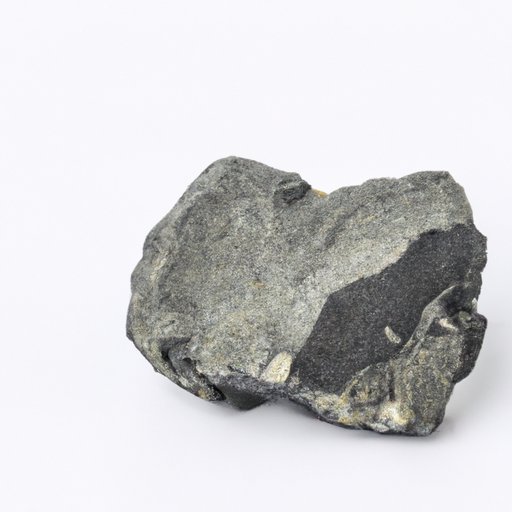Introduction
Gabbro is an intrusive igneous rock which forms through the slow crystallization of mafic magma. It is a coarse-grained rock with interlocking crystals, and it is usually dark in color. Gabbro is commonly found in oceanic crust and is a major component of the lower oceanic crust. To understand why gabbro is a rock and not a mineral, it is important to look at its physical properties, formation process, and uses.
Physical Properties of Gabbro
Gabbro is composed mainly of plagioclase feldspar (50-90%) and pyroxene (10-50%). It also contains minor amounts of olivine, amphibole, biotite, magnetite, and quartz. Gabbro has a granular texture, and its crystals are usually between 0.5 mm and 5 mm in size. The grain size is often used to differentiate gabbro from minerals, as minerals typically have smaller grains.
Gabbro typically has a dull luster, and its colors range from black to dark green. The color of gabbro is determined by the presence of iron and magnesium. Gabbro may also contain trace amounts of other elements, such as titanium, chromium, and nickel.
Formation Process
Gabbro is formed when mafic magma cools slowly beneath the Earth’s surface. Mafic magma is rich in iron and magnesium, and it is usually formed deep within the Earth’s mantle. As the magma rises towards the surface, it begins to cool and form crystals. These crystals become larger and more closely packed as the magma continues to cool. Eventually, the magma becomes solid and forms a mass of interlocking crystals, which is known as gabbro.
Because gabbro forms beneath the Earth’s surface, it is classified as an intrusive igneous rock. Intrusive rocks form when molten material cools and solidifies beneath the surface. In contrast, extrusive rocks form when molten material is violently ejected from the Earth’s surface, such as during a volcanic eruption.
Chemical Composition
Gabbro is composed mainly of plagioclase feldspar and pyroxene. Plagioclase feldspar is a group of minerals which are composed mainly of calcium, sodium, and aluminum. Pyroxene is a group of minerals which are composed mainly of calcium, magnesium, and iron. Gabbro also contains minor amounts of other minerals, such as olivine, amphibole, biotite, magnetite, and quartz.
The chemical composition of gabbro varies depending on the type of magma from which it was formed. For example, gabbro formed from basaltic magma will contain more iron and magnesium than gabbro formed from andesitic magma. Gabbro can also be enriched in certain elements due to weathering or metamorphism.
Uses of Gabbro
Gabbro is a versatile rock which is used in a variety of industries. It is used as a crushed stone for road construction, railroad ballast, and fill material. Gabbro is also used in landscaping, as it is an attractive and durable rock which can be used for retaining walls and walkways. Additionally, gabbro is used as an aggregate in concrete and asphalt.
Gabbro is also used in the construction industry, as it is a strong and durable rock which can be used for building foundations and walls. Furthermore, gabbro is used in the production of cement, as it is an abundant source of calcium and other minerals needed for cement production.
However, the extraction of gabbro can have a negative environmental impact. Mining operations can cause air and water pollution, as well as soil erosion. Additionally, the transportation of gabbro can result in increased noise and traffic.
Comparison to Other Rocks and Minerals
Gabbro can be distinguished from other rocks and minerals by its physical properties. Its coarse-grained texture and large crystals make it unique among rocks and minerals. Additionally, its dull luster and dark colors make it easy to identify.
Gabbro is also distinct from other rocks and minerals in terms of its formation process. Most rocks and minerals form at the Earth’s surface, while gabbro forms beneath the surface. This means that gabbro is less likely to be affected by weathering and metamorphism than other rocks and minerals.
Conclusion
Gabbro is an intrusive igneous rock which forms from the slow crystallization of mafic magma. It is composed mainly of plagioclase feldspar and pyroxene, and it has a granular texture with large crystals. Gabbro is used in a variety of industries, including road construction, landscaping, and cement production. It can be distinguished from other rocks and minerals by its physical properties and formation process.
Further research is needed to better understand the uses and environmental impacts of gabbro. Additionally, further study could help identify new ways to use this unique and versatile rock.
(Note: Is this article not meeting your expectations? Do you have knowledge or insights to share? Unlock new opportunities and expand your reach by joining our authors team. Click Registration to join us and share your expertise with our readers.)
